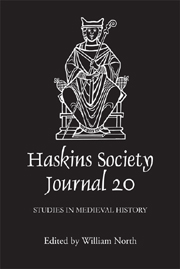Book contents
- Frontmatter
- Contents
- Editor's Note
- Abbreviations
- 1 Buckets, Monasteries, and Crannógs: Material Culture and the Rewriting of Early Medieval British History
- 2 Punishing Bodies and Saving Souls: Capital and Corporal Punishment in Late Anglo-Saxon England
- 3 Writing Latin History for a Lay Audience c. 1000: Dudo of Saint Quentin at the Norman Court
- 4 Between Neighbors and Saints: Waleran I of Meulan and the Allegiance of Lesser Lords in the Eleventh Century
- 5 Who Founded Durtal? Reconsidering the Evidence
- 6 Robert Curthose: Ineffectual Duke or Victim of Spin
- 7 The Chivalric Transformation and the Origins of Tournament as seen through Norman Chroniclers
- 8 An Internal Frontier? The Relationship between Mainland Southern Italy and Sicily in the ‘Norman’ Kingdom
- 9 ‘Hywel in the World’
- 10 Prices, Price Controls, and Market Forces in England under Edward I c. 1294–1307
8 - An Internal Frontier? The Relationship between Mainland Southern Italy and Sicily in the ‘Norman’ Kingdom
Published online by Cambridge University Press: 12 September 2012
- Frontmatter
- Contents
- Editor's Note
- Abbreviations
- 1 Buckets, Monasteries, and Crannógs: Material Culture and the Rewriting of Early Medieval British History
- 2 Punishing Bodies and Saving Souls: Capital and Corporal Punishment in Late Anglo-Saxon England
- 3 Writing Latin History for a Lay Audience c. 1000: Dudo of Saint Quentin at the Norman Court
- 4 Between Neighbors and Saints: Waleran I of Meulan and the Allegiance of Lesser Lords in the Eleventh Century
- 5 Who Founded Durtal? Reconsidering the Evidence
- 6 Robert Curthose: Ineffectual Duke or Victim of Spin
- 7 The Chivalric Transformation and the Origins of Tournament as seen through Norman Chroniclers
- 8 An Internal Frontier? The Relationship between Mainland Southern Italy and Sicily in the ‘Norman’ Kingdom
- 9 ‘Hywel in the World’
- 10 Prices, Price Controls, and Market Forces in England under Edward I c. 1294–1307
Summary
In 1130, the Kingdom of Sicily was established by Roger II. This so-called ‘Norman’ kingdom has long been considered a model of medieval centralized government. This reputation is especially impressive given that the region had no previous tradition of such government, and that it was formed from diverse regional entities that straddled the South Italian mainland and the island of Sicily and comprised an equally diverse range of ethnic and denominational groups: Normanno-French, Muslims, Greeks, Jews, and Lombards. While the power of Sicilian royal administration cannot be denied, it is now apparent that it did not cover all parts of the realm with equal intensity. Whence there arises the important question of how far the kingdom was a unified whole with its own sense of identity. While there is not sufficient space here to offer an answer that would do justice to the complexity of that question, it is possible to explore briefly one element of it: the relationship between the two main constituent parts of the kingdom, mainland Southern Italy and the island of Sicily, during the period 1130–94.
It must be noted at the outset that the use of these two broad areas of the mainland and the island as categories is in no way intended to overlook the regional diversity within each. The mainland consisted of a variety of component parts including Calabria, Lucania, Campania, Apulia (itself divided into distinct northern, southern and central regions), and the Abruzzi, while Sicily had a Greek-influenced north-eastern zone and a Muslim-influenced south and west.
- Type
- Chapter
- Information
- The Haskins Society Journal 202008 - Studies in Medieval History, pp. 161 - 174Publisher: Boydell & BrewerPrint publication year: 2009



